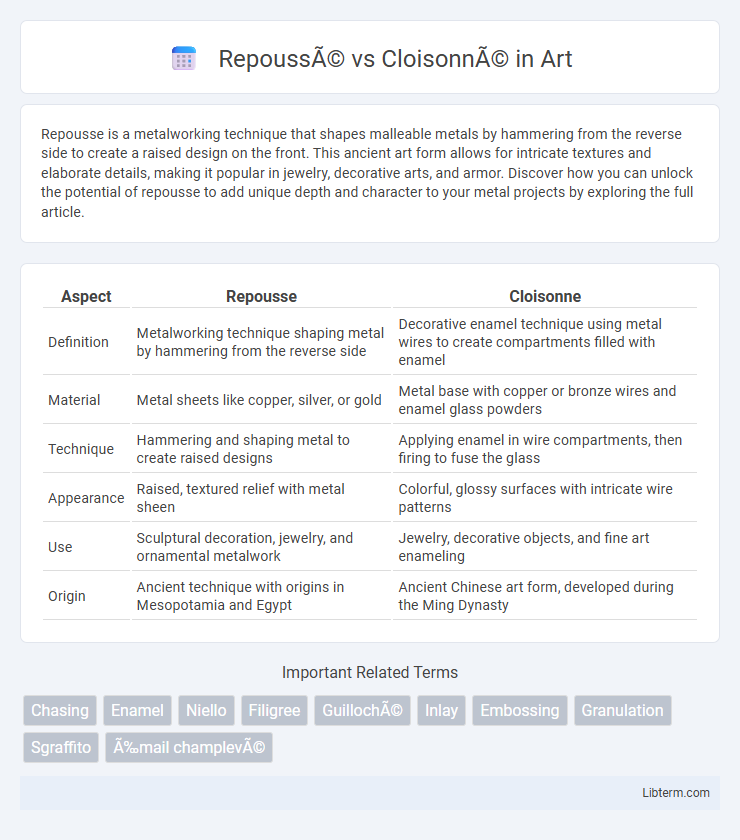Repousse is a metalworking technique that shapes malleable metals by hammering from the reverse side to create a raised design on the front. This ancient art form allows for intricate textures and elaborate details, making it popular in jewelry, decorative arts, and armor. Discover how you can unlock the potential of repousse to add unique depth and character to your metal projects by exploring the full article.
Table of Comparison
| Aspect | Repousse | Cloisonne |
|---|---|---|
| Definition | Metalworking technique shaping metal by hammering from the reverse side | Decorative enamel technique using metal wires to create compartments filled with enamel |
| Material | Metal sheets like copper, silver, or gold | Metal base with copper or bronze wires and enamel glass powders |
| Technique | Hammering and shaping metal to create raised designs | Applying enamel in wire compartments, then firing to fuse the glass |
| Appearance | Raised, textured relief with metal sheen | Colorful, glossy surfaces with intricate wire patterns |
| Use | Sculptural decoration, jewelry, and ornamental metalwork | Jewelry, decorative objects, and fine art enameling |
| Origin | Ancient technique with origins in Mesopotamia and Egypt | Ancient Chinese art form, developed during the Ming Dynasty |
Introduction to Metal Art Techniques
Repousse and cloisonne are two distinct metal art techniques utilized for decorative purposes, each showcasing unique craftsmanship. Repousse involves shaping metal by hammering from the reverse side to create a raised design, emphasizing texture and depth in the metal surface. Cloisonne, in contrast, uses thin metal wires to form compartments that are filled with enamel, resulting in vibrant, colorful patterns sealed within delicate metal outlines.
What is Repoussé?
Repousse is a metalworking technique where malleable metal is shaped by hammering from the reverse side to create a design in low relief. This ancient art form allows for intricate, three-dimensional patterns and textures on metal surfaces such as copper, silver, or gold. Unlike cloisonne, which uses enamel and wire partitions, repousse emphasizes sculpting the metal itself without adding colored inlays.
The History of Repoussé
Repousse is an ancient metalworking technique dating back to the Bronze Age, characterized by hammering malleable metal from the reverse side to create intricate raised designs. Historically prominent in cultures such as the Egyptians, Greeks, and Etruscans, repousse was used to decorate armor, jewelry, and religious artifacts, showcasing craftsmanship and artistic expression. Its enduring appeal lies in its ability to produce detailed relief work that combines texture and depth without the need for added materials.
What is Cloisonné?
Cloisonne is an ancient metalworking technique where thin metal wires are shaped and adhered to a metal surface to create compartments, which are then filled with enamel or gemstones. The compartments (cloisons) create intricate designs with vibrant colors after firing and polishing. This technique differs from repousse, which involves hammering metal from the reverse side to create raised designs without the use of enamel-filled compartments.
The History of Cloisonné
Cloisonne originated in the Byzantine Empire around the 6th century and later flourished in China during the Ming and Qing dynasties, becoming a symbol of imperial artistry. This ancient technique involves creating intricate designs by filling metal compartments, called cloisons, with enamel, demonstrating advanced craftsmanship. Unlike repousse, which shapes metal by hammering from the reverse side to create relief, cloisonne's distinctive decorative appeal lies in its vibrant enamel surfaces set within finely crafted metal partitions.
Key Differences: Repoussé vs Cloisonné
Repousse is a metalworking technique where metal sheets are shaped by hammering from the reverse side to create a raised design, emphasizing texture and relief. Cloisonne involves creating compartments (cloisons) on a metal surface using thin metal wires, which are then filled with enamel to produce colorful, intricate designs. The key difference lies in repousse's focus on shaping metal itself versus cloisonne's use of metal partitions to contain enamel decoration.
Materials Used in Repoussé and Cloisonné
Repousse involves shaping metal sheets such as copper, silver, or gold by hammering from the reverse side to create raised designs, emphasizing malleable metals that can withstand extensive shaping. Cloisonne uses a metal base, often copper or bronze, with fine wire partitions made of metal such as gold or brass to create compartments that are then filled with vitreous enamel, resulting in colorful, glossy surfaces. The choice of materials in repousse relies on ductility and softness for detailed embossing, while cloisonne prioritizes metals that support enamel adherence and wire precision for intricate patterns.
Artistic Applications and Styles
Repousse involves hammering metal from the reverse side to create raised designs, often used in sculpture and jewelry for intricate, textured surfaces. Cloisonne employs thin metal wires to form compartments filled with enamel, creating colorful, detailed patterns popular in decorative arts and jewelry. Both techniques showcase distinct artistic styles: repousse emphasizes relief and dimensionality, while cloisonne highlights vibrant, segmented color designs.
Preservation and Care of Metal Art
Repousse and cloisonne are distinct metalworking techniques requiring specialized preservation methods to maintain their intricate designs and materials. Repousse, involving raised relief by hammering metal from the reverse side, demands protection from moisture and aggressive polishing to prevent deformation of delicate details. Cloisonne, characterized by colorful enamel separated by metal wires, needs controlled humidity and gentle cleaning with non-abrasive materials to preserve the enamel's vibrancy and prevent cracking or tarnishing of metal partitions.
Choosing Between Repoussé and Cloisonné
Choosing between repousse and cloisonne depends on the desired artistic effect and material constraints. Repousse offers intricate three-dimensional relief by hammering metal from the reverse side, ideal for bold, textured designs in metals like copper or silver. Cloisonne excels in vibrant enamel decoration within fine metal partitions, perfect for colorful, detailed patterns on jewelry or decorative objects.
Repoussé Infographic

 libterm.com
libterm.com